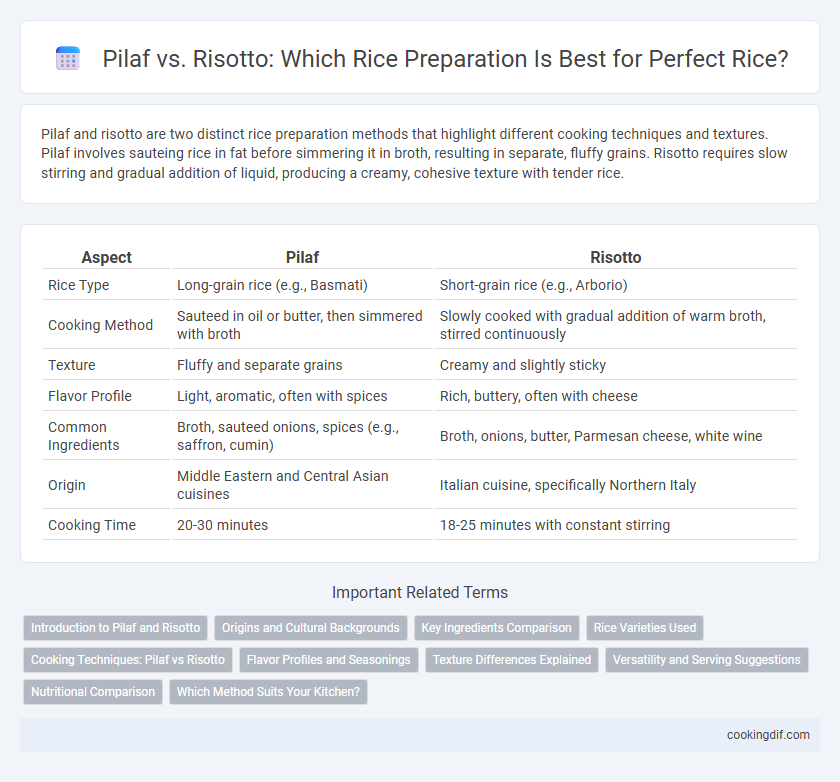Pilaf and risotto are two distinct rice preparation methods that highlight different cooking techniques and textures. Pilaf involves sauteing rice in fat before simmering it in broth, resulting in separate, fluffy grains. Risotto requires slow stirring and gradual addition of liquid, producing a creamy, cohesive texture with tender rice.
Table of Comparison
| Aspect | Pilaf | Risotto |
|---|---|---|
| Rice Type | Long-grain rice (e.g., Basmati) | Short-grain rice (e.g., Arborio) |
| Cooking Method | Sauteed in oil or butter, then simmered with broth | Slowly cooked with gradual addition of warm broth, stirred continuously |
| Texture | Fluffy and separate grains | Creamy and slightly sticky |
| Flavor Profile | Light, aromatic, often with spices | Rich, buttery, often with cheese |
| Common Ingredients | Broth, sauteed onions, spices (e.g., saffron, cumin) | Broth, onions, butter, Parmesan cheese, white wine |
| Origin | Middle Eastern and Central Asian cuisines | Italian cuisine, specifically Northern Italy |
| Cooking Time | 20-30 minutes | 18-25 minutes with constant stirring |
Introduction to Pilaf and Risotto
Pilaf is a rice preparation method where rice grains are sauteed in oil or butter before simmering in broth, resulting in separate, fluffy grains infused with rich flavors. Risotto, originating from Italy, involves slowly cooking short-grain Arborio rice in broth while stirring continuously to release starches, creating a creamy and velvety texture. Both techniques highlight distinct textures and flavor profiles, with pilaf emphasizing individual grain integrity and risotto focusing on creaminess.
Origins and Cultural Backgrounds
Pilaf, originating from Middle Eastern and Central Asian cuisines, features rice cooked in seasoned broth with vegetables, spices, and meat, reflecting ancient Persian culinary traditions. Risotto hails from northern Italy, characterized by its creamy texture achieved through slow cooking of Arborio rice combined with broth and often enriched with cheese and butter. Both dishes showcase regional agricultural staples and cooking techniques that highlight distinct cultural heritages in rice preparation.
Key Ingredients Comparison
Pilaf typically uses long-grain rice varieties such as Basmati or Jasmine, cooked with broth, sauteed onions, and spices like cumin or bay leaves for a fluffy, separate grain texture, while risotto relies on short-grain Arborio rice, slowly stirred and gradually cooked with broth, butter, and Parmesan cheese to achieve its creamy consistency. Key ingredients in pilaf emphasize aromatic spices and broth absorption, whereas risotto features a slow-release starch process enhanced by constant stirring and rich dairy additions. The fundamental contrast lies in rice type and cooking technique, influencing the dish's texture and flavor complexity.
Rice Varieties Used
Pilaf typically uses long-grain rice varieties such as Basmati or Jasmine, prized for their separate, fluffy grains after cooking. Risotto requires short-grain rice types like Arborio or Carnaroli, known for their high starch content that creates a creamy texture. Choosing the right rice variety is essential to achieve the traditional consistency and flavor unique to each dish.
Cooking Techniques: Pilaf vs Risotto
Pilaf is prepared by sauteing rice grains in oil or butter before simmering in a measured amount of broth, resulting in fluffy, separate grains. Risotto involves slowly cooking rice while gradually adding warm broth and stirring constantly, creating a creamy, cohesive texture. The pilaf technique emphasizes dryness and separation, whereas risotto relies on continuous stirring to release starches for richness.
Flavor Profiles and Seasonings
Pilaf rice is characterized by a nutty flavor achieved by sauteing grains in oil or butter before simmering with broth and aromatic spices such as cumin, cardamom, and bay leaves. Risotto offers a creamy texture with a rich, savory profile from slow-cooked Arborio rice infused with ingredients like Parmesan cheese, white wine, garlic, and shallots. The seasoning in pilaf emphasizes warm spices and broth, while risotto relies on a balance of dairy and wine to enhance its depth and creaminess.
Texture Differences Explained
Pilaf features separate, fluffy grains achieved by sauteing rice in fat before simmering in broth, ensuring each grain remains distinct and firm. Risotto is creamy and velvety due to the use of short-grain arborio rice, which releases starch during slow cooking and constant stirring. The texture difference stems from pilaf's dry, fluffy consistency versus risotto's rich, cohesive creaminess.
Versatility and Serving Suggestions
Pilaf and risotto exemplify distinct rice preparation styles, each offering unique versatility in dishes. Pilaf employs a method of sauteing rice grains in oil or butter before simmering with broth, producing fluffy, separate grains ideal for pairing with roasted meats, vegetables, or as a base in Middle Eastern and Mediterranean cuisines. Risotto features a creamy texture achieved through gradual broth absorption and constant stirring of Arborio rice, making it perfect for rich, savory combinations with seafood, mushrooms, or cheese in Italian culinary traditions.
Nutritional Comparison
Pilaf and risotto differ significantly in their nutritional profiles due to distinct cooking methods and ingredient choices. Pilaf is typically prepared by sauteing rice in oil or butter before simmering it in broth, often resulting in a lower calorie and fat content compared to risotto, which incorporates substantial amounts of butter, cheese, and cream, increasing saturated fat levels. Risotto's creamy texture adds calories and fat, making pilaf a lighter option with potentially higher fiber content when using whole grain rice varieties.
Which Method Suits Your Kitchen?
Pilaf and risotto differ significantly in cooking technique and texture, making each suitable for specific kitchen preferences. Pilaf involves sauteing rice in fat before cooking it in a measured amount of broth, yielding fluffy, separate grains ideal for those seeking a hands-off, consistent method. Risotto requires constant stirring and gradual broth addition to create a creamy, rich texture, perfect for kitchens where time and attention to detail are prioritized.
Pilaf vs Risotto for rice preparation Infographic

 cookingdif.com
cookingdif.com